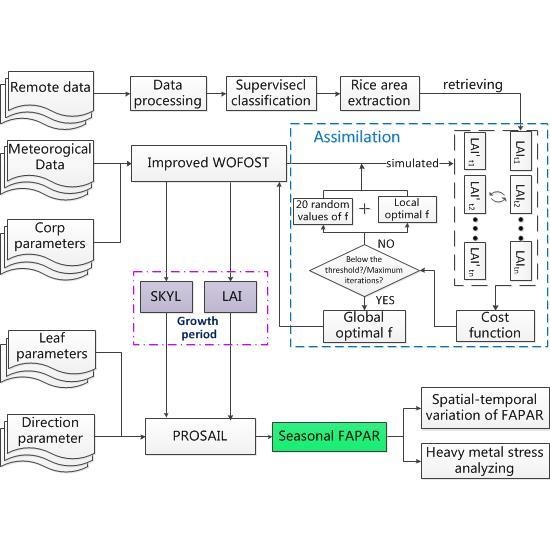Estimating FAPAR of Rice Growth Period Using Radiation Transfer Model Coupled with the WOFOST Model for Analyzing Heavy Metal Stress
Abstract
:1. Introduction
2. Materials and Methods
2.1. Study Area and Data
2.1.1. Study Area
2.1.2. Data Preparation
2.2. Methods
2.2.1. FAPAR Calculation Based on PROSAIL Model
2.2.2. LAI Assimilation into the WOFOST Model
2.2.3. Simulation of Seasonal Dynamics of FAPAR
3. Results
3.1. Validation of FAPAR
3.2. Seasonal Changes in FAPAR in Response to Heavy Metal Stress
3.3. Spatial-Temporal Analysis of FAPAR
4. Discussion
5. Conclusions
Acknowledgments
Author Contributions
Conflicts of Interest
References
- Gitelson, A.A.; Vina, A.; Arkebauer, T.J.; Rundquist, D.C.; Keydan, G.; Leavitt, B. Remote estimation of leaf area index and green leaf biomass in maize canopies. Geophys. Res. Lett. 2003, 30. [Google Scholar] [CrossRef]
- Song, W.; Chen, B.; Liu, L. Soil heavy metal pollution of cultivated land in China. Res. Soil Water Conserv. 2013, 20, 293–298. [Google Scholar]
- Wu, L.; Liu, X.; Wang, P.; Zhou, B.; Liu, M.; Li, X. The assimilation of spectral sensing and the wofost model for the dynamic simulation of cadmium accumulation in rice tissues. Int. J. Appl. Earth Obs. Geoinfor. 2013, 25, 66–75. [Google Scholar] [CrossRef]
- Song, Q.; Li, J. Environmental effects of heavy metals derived from the e-waste recycling activities in China: A systematic review. Waste Manag. 2014, 34, 2587–2594. [Google Scholar] [CrossRef] [PubMed]
- Jin, M.; Liu, X.N.; Wu, L.; Liu, M.L. An improved assimilation method with stress factors incorporated in the wofost model for the efficient assessment of heavy metal stress levels in rice. Int. J. Appl. Earth Obs. Geoinf. 2015, 41, 118–129. [Google Scholar] [CrossRef]
- Kastori, R.; Plesnicar, M.; Sakac, Z.; Pankovic, D.; Arsenijevic-Maksimovic, I. Effect of excess lead on sunflower growth and photosynthesis. J. Plant Nutr. 1998, 21, 75–85. [Google Scholar] [CrossRef]
- Rahman, M.A.; Hasegawa, H.; Rahman, M.M.; Islam, M.N.; Miah, M.A.M.; Tasmen, A. Effect of arsenic on photosynthesis, growth and yield of five widely cultivated rice (Oryza sativa L.) varieties in Bangladesh. Chemosphere 2007, 67, 1072–1079. [Google Scholar] [CrossRef] [PubMed]
- Cheng, S.P. Effects of heavy metals on plants and resistance mechanisms. Environ. Sci. Pollut. Res. 2003, 10, 256–264. [Google Scholar] [CrossRef]
- Schuerger, A.C.; Capelle, G.A.; Di Benedetto, J.A.; Mao, C.Y.; Thai, C.N.; Evans, M.D.; Richards, J.T.; Blank, T.A.; Stryjewski, E.C. Comparison of two hyperspectral imaging and two laser-induced fluorescence instruments for the detection of zinc stress and chlorophyll concentration in bahia grass (paspalum notatum flugge). Remote Sens. Environ. 2003, 84, 572–588. [Google Scholar] [CrossRef]
- Rosso, P.H.; Pushnik, J.C.; Lay, M.; Ustin, S.L. Reflectance properties and physiological responses of salicornia virginica to heavy metal and petroleum contamination. Environ. Pollut. 2005, 137, 241–252. [Google Scholar] [CrossRef] [PubMed]
- Sridhar, B.B.M.; Vincent, R.K.; Roberts, S.J.; Czajkowski, K. Remote sensing of soybean stress as an indicator of chemical concentration of biosolid amended surface soils. Int. J. Appl. Earth Obs. Geoinfor. 2011, 13, 676–681. [Google Scholar] [CrossRef]
- Chen, J.M. Canopy architecture and remote sensing of the fraction of photosynthetically active radiation absorbed by boreal conifer forests. IEEE Trans. Geosci. Remote Sens. 1996, 34, 1353–1368. [Google Scholar] [CrossRef]
- Asner, G.P.; Wessman, C.A. Scaling par absorption from the leaf to landscape level in spatially heterogeneous ecosystems. Ecol. Model. 1997, 103, 81–97. [Google Scholar] [CrossRef]
- Zhu, Z.; Bi, J.; Pan, Y.; Ganguly, S.; Anav, A.; Xu, L.; Samanta, A.; Piao, S.; Nemani, R.; Myneni, R. Global data sets of vegetation leaf area index (lai)3g and Fraction of Photosynthetically Active Radiation (FPAR)3G derived from Global Inventory Modeling and Mapping Studies (GIMMS) Normalized Difference Vegetation Index (NDVI3G) for the period 1981 to 2011. Remote Sens. 2013, 5, 927–948. [Google Scholar]
- Liu, J.; Pattey, E.; Miller, J.R.; McNairn, H.; Smith, A.; Hu, B. Estimating crop stresses, aboveground dry biomass and yield of corn using multi-temporal optical data combined with a radiation use efficiency model. Remote Sens. Environ. 2010, 114, 1167–1177. [Google Scholar] [CrossRef]
- Dong, T.; Wu, B.; Meng, J.; Du, X.; Shang, J. Sensitivity analysis of retrieving Fraction of Absorbed Photosynthetically Active Radiation (FPAR) using remote sensing data. Acta Ecol. Sin. 2016, 36, 1–7. [Google Scholar] [CrossRef]
- Liu, M.; Liu, X.; Zhang, B.; Ding, C. Regional heavy metal pollution in crops by integrating physiological function variability with spatio-temporal stability using multi-temporal thermal remote sensing. Int. J. Appl. Earth Obs. Geoinfor. 2016, 51, 91–102. [Google Scholar] [CrossRef]
- Liang, S. Recent developments in estimating land surface biogeophysical variables from optical remote sensing. Prog. Phys. Geogr. 2007, 31, 501–516. [Google Scholar] [CrossRef]
- Yuan, H.; Ma, R.; Atzberger, C.; Li, F.; Loiselle, S.; Luo, J. Estimating forest fapar from multispectral landsat-8 data using the invertible forest reflectance model inform. Remote Sens. 2015, 7, 7425–7446. [Google Scholar] [CrossRef]
- Tao, X.; Liang, S.; He, T.; Jin, H. Estimation of fraction of absorbed photosynthetically active radiation from multiple satellite data: Model development and validation. Remote Sens. Environ. 2016, 184, 539–557. [Google Scholar] [CrossRef]
- Steinberg, D.C.; Goetz, S.J.; Hyer, E.J. Validation of modis f-par products in boreal forests of Alaska. IEEE Trans. Geosci. Remote Sens. 2006, 44, 1818–1828. [Google Scholar] [CrossRef]
- Verger, A.; Baret, F.; Camacho, F. Optimal modalities for radiative transfer-neural network estimation of canopy biophysical characteristics: Evaluation over an agricultural area with chris/proba observations. Remote Sens. Environ. 2011, 115, 415–426. [Google Scholar] [CrossRef]
- Oliphant, A.; Susan, C.; Grimmond, B.; Schmid, H.P.; Wayson, C.A. Local-scale heterogeneity of Photosynthetically Active Radiation (PAR), absorbed par and net radiation as a function of topography, sky conditions and leaf area index. Remote Sens. Environ. 2006, 103, 324–337. [Google Scholar] [CrossRef]
- Zhang, Q.; Middleton, E.M.; Margolis, H.A.; Drolet, G.G.; Barr, A.A.; Black, T.A. Can a satellite-derived estimate of the Fraction of PAR Absorbed by Chlorophyll (FAPAR(CHL)) improve predictions of light-use efficiency and ecosystem photosynthesis for a boreal aspen forest? Remote Sens. Environ. 2009, 113, 880–888. [Google Scholar] [CrossRef]
- Cheng, S.J.; Bohrer, G.; Steiner, A.L.; Hollinger, D.Y.; Suyker, A.; Phillips, R.P.; Nadelhoffer, K.J. Variations in the influence of diffuse light on gross primary productivity in temperate ecosystems. Agric. For. Meteorol. 2015, 201, 98–110. [Google Scholar] [CrossRef]
- Li, W.; Fang, H. Estimation of direct, diffuse, and total fpars from landsat surface reflectance data and ground-based estimates over six fluxnet sites. J. Geophys. Res. Biogeosci. 2015, 120, 96–112. [Google Scholar] [CrossRef]
- Xue, W.; Lindner, S.; Nay-Htoon, B.; Dubbert, M.; Otieno, D.; Ko, J.; Muraoka, H.; Werner, C.; Tenhunen, J.; Harley, P. Nutritional and developmental influences on components of rice crop light use efficiency. Agric. For. Meteorol. 2016, 223, 1–16. [Google Scholar] [CrossRef]
- Li, L.; Du, Y.; Tang, Y.; Liu, Q. A study of fraction of absorbed photosynthetically active radiation characteristics based on SAIL model simulation. Proc. SPIE 2012. [Google Scholar] [CrossRef]
- Liu, F.; Liu, X.N.; Wu, L.; Xu, Z.; Gong, L. Optimizing the temporal scale in the assimilation of remote sensing and wofost model for dynamically monitoring heavy metal stress in rice. IEEE J. Sel. Top. Appl. Earth Obs. Remote Sens. 2016, 9, 1685–1695. [Google Scholar] [CrossRef]
- Jin, M.; Liu, X.N.; Wu, L.; Liu, M.L. Distinguishing heavy-metal stress levels in rice using synthetic spectral index responses to physiological function variations. IEEE J. Sel. Top. Appl. Earth Obs. Remote Sens. 2017, 10, 75–86. [Google Scholar] [CrossRef]
- Feret, J.-B.; Francois, C.; Asner, G.P.; Gitelson, A.A.; Martin, R.E.; Bidel, L.P.R.; Ustin, S.L.; le Maire, G.; Jacquemoud, S. Prospect-4 and 5: Advances in the leaf optical properties model separating photosynthetic pigments. Remote Sens. Environ. 2008, 112, 3030–3043. [Google Scholar] [CrossRef]
- Jacquemoud, S.; Verhoef, W.; Baret, F.; Bacour, C.; Zarco-Tejada, P.J.; Asner, G.P.; Francois, C.; Ustin, S.L. Prospect plus sail models: A review of use for vegetation characterization. Remote Sens. Environ. 2009, 113, S56–S66. [Google Scholar] [CrossRef]
- Asner, G.P.; Wessman, C.A.; Archer, S. Scale dependence of absorption of photosynthetically active radiation in terrestrial ecosystems. Ecol. Appl. 1998, 8, 1003. [Google Scholar] [CrossRef]
- Asner, G.P.; Townsend, A.R.; Riley, W.J.; Matson, P.A.; Neff, J.C.; Cleveland, C.C. Physical and biogeochemical controls over terrestrial ecosystem responses to nitrogen deposition. Biogeochemistry 2001, 54, 1–39. [Google Scholar] [CrossRef]
- Lobell, D.B.; Asner, G.P.; Ortiz-Monasterio, J.I.; Benning, T.L. Remote sensing of regional crop production in the yaqui valley, mexico: Estimates and uncertainties. Agric. Ecosyst. Environ. 2003, 94, 205–220. [Google Scholar] [CrossRef]
- Dong, T.; Meng, J.; Wu, B. Overview on methods of deriving fraction of absorbed Photosynthetically Active Radiation (FPAR) using remote sensing. Acta Ecol. Sin. 2012, 32, 7190–7201. [Google Scholar] [CrossRef]
- Verhoef, W.; Bach, H. Coupled soil–leaf-canopy and atmosphere radiative transfer modeling to simulate hyperspectral multi-angular surface reflectance and toa radiance data. Remote Sens. Environ. 2007, 109, 166–182. [Google Scholar] [CrossRef]
- Huang, Z.; Liu, X.N.; Jin, M.; Ding, C.; Jiang, J.L.; Wu, L. Deriving the characteristic scale for effectively monitoring heavy metal stress in rice by assimilation of gf-1 data with the wofost model. Sensors 2016. [Google Scholar] [CrossRef] [PubMed]
- Zhaohui, G.U.O.; Xiyuan, X.; Tongbin, C.; Xiaoyong, L.; Jie, S.; Bin, W.U. Heavy metal pollution of soils and vegetables from midstream and downstream of xiangjiang river. Acta Geogr. Sin. 2008, 63, 3–11. [Google Scholar]
- Liu, F.; Liu, X.; Zhao, L.; Ding, C.; Jiang, J.; Wu, L. The dynamic assessment model for monitoring cadmium stress levels in rice based on the assimilation of remote sensing and the wofost model. IEEE J. Sel. Top. Appl. Earth Obs. Remote Sens. 2015, 8, 1330–1338. [Google Scholar] [CrossRef]
- Liu, M.; Liu, X.; Liu, M.; Liu, F.; Jin, M.; Wu, L. Root mass ratio: Index derived by assimilation of synthetic aperture radar and the improved world food study model for heavy metal stress monitoring in rice. J. Appl. Remote Sens. 2016, 10, 026038. [Google Scholar] [CrossRef]
- Hosgood, B.; Jacquemoud, S.; Andreoli, G.; Verdebout, J.; Pedrini, G.; Schmuck, G. Leaf optical properties experiment 93 (lopex93). Available online: http://data.ecosis.org/dataset/13aef0ce-dd6f-4b35-91d9-28932e506c41/resource/4029b5d3-2b84-46e3-8fd8-c801d86cf6f1/download/leaf-optical-properties-experiment-93-lopex93.pdf (accessed on 10 March 2017).
- Ceccato, P.; Flasse, S.; Tarantola, S.; Jacquemoud, S.; Grégoire, J.-M. Detecting vegetation leaf water content using reflectance in the optical domain. Remote Sens. Environ. 2001, 77, 22–33. [Google Scholar] [CrossRef]
- Fang, M.H.; Ju, W.M. A inversion model for remote sensing of leaf water content based on the leaf optical property. Spectrosc. Spectr. Anal. 2015, 35, 167–171. [Google Scholar]
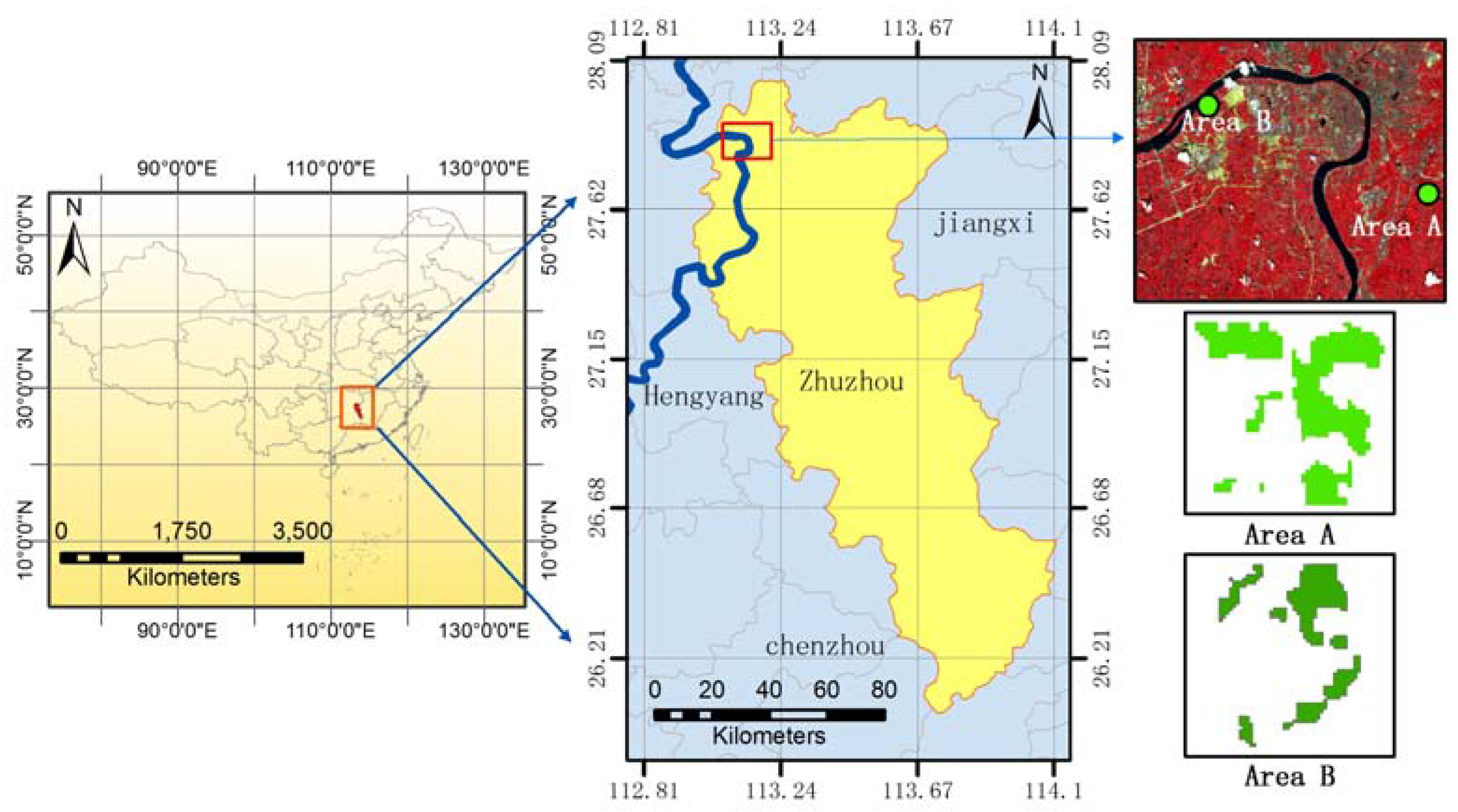
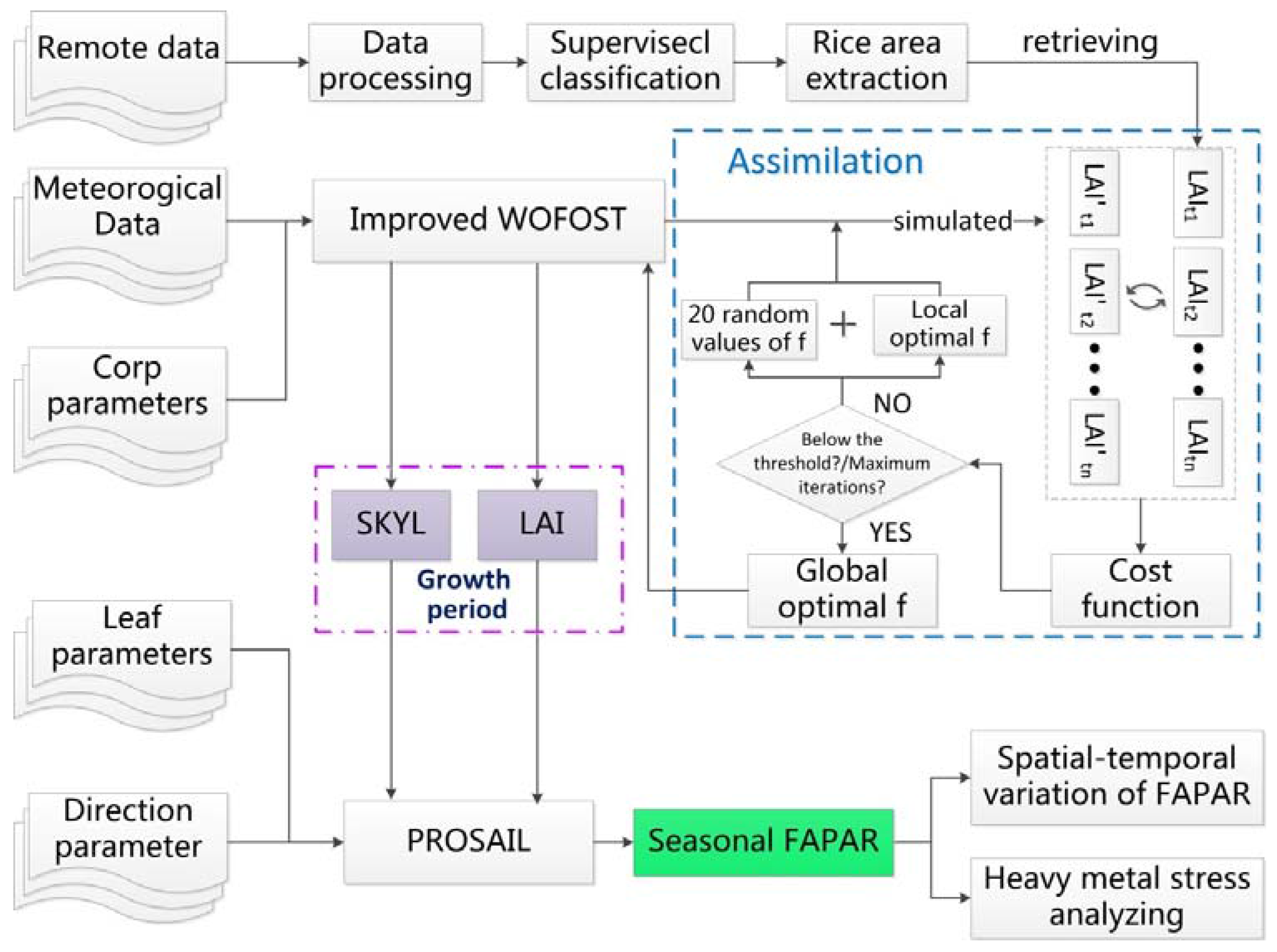
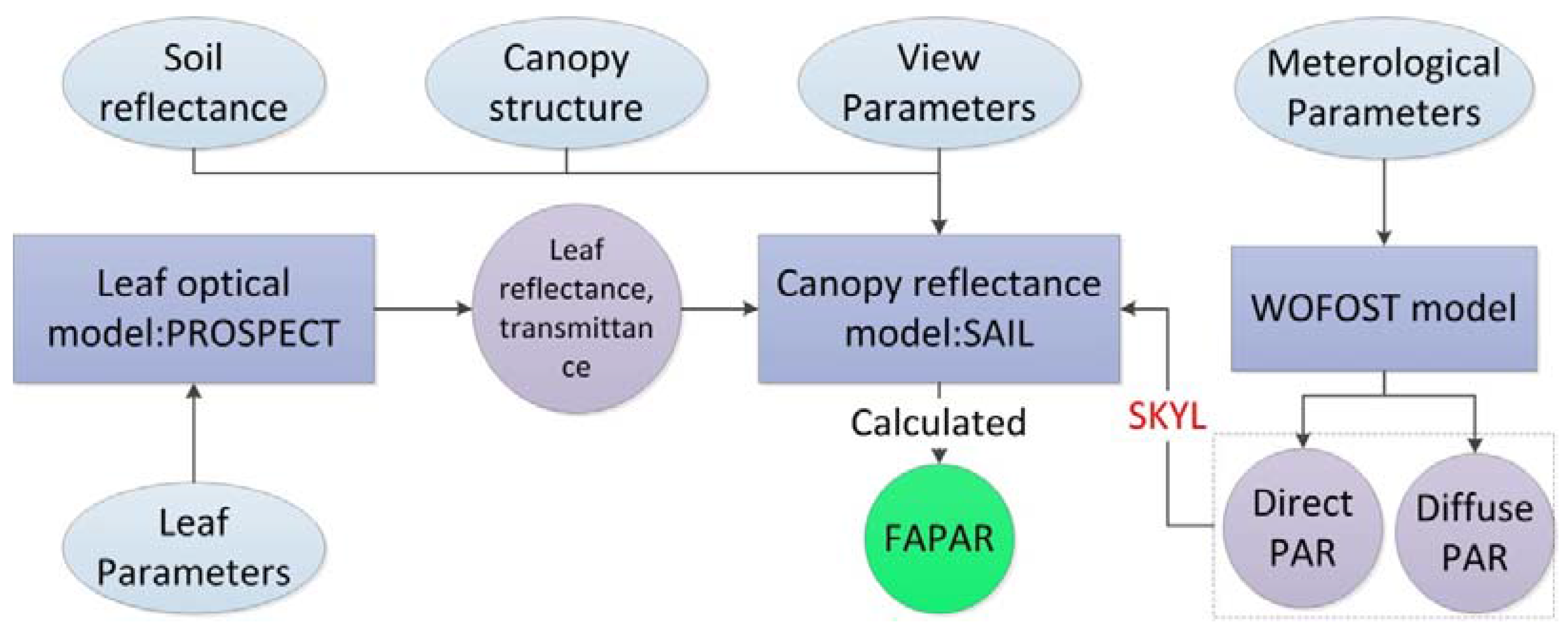
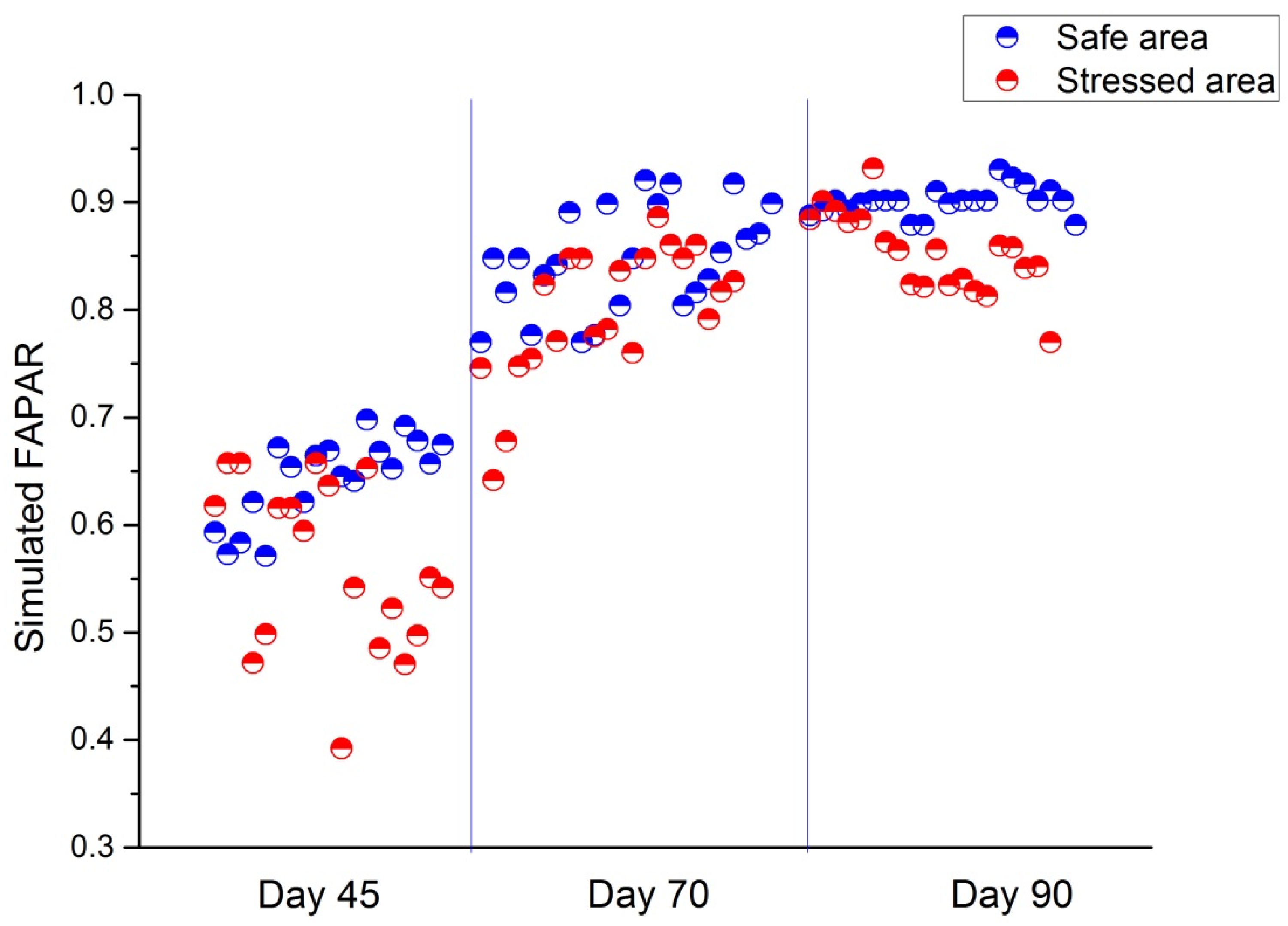
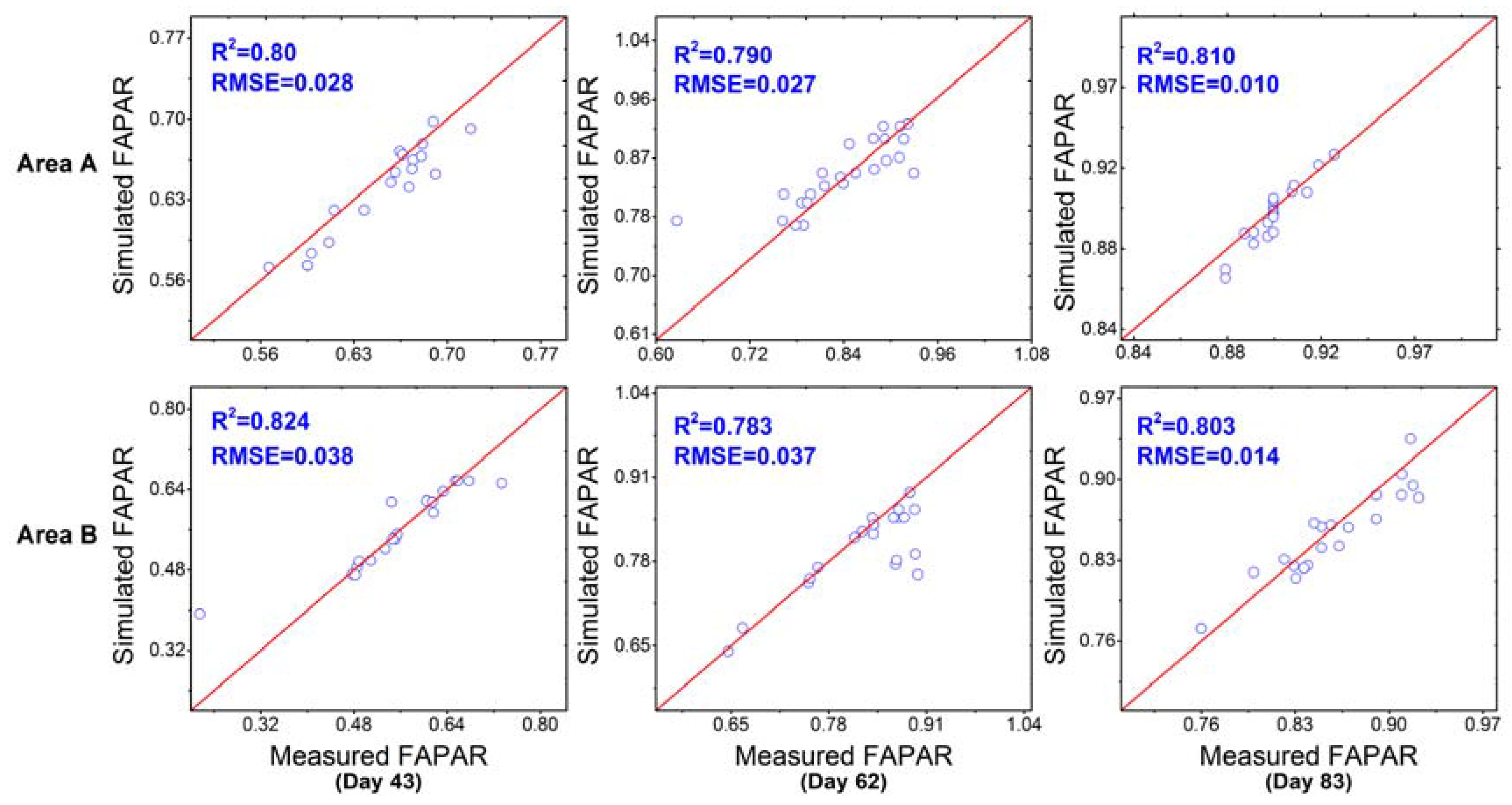
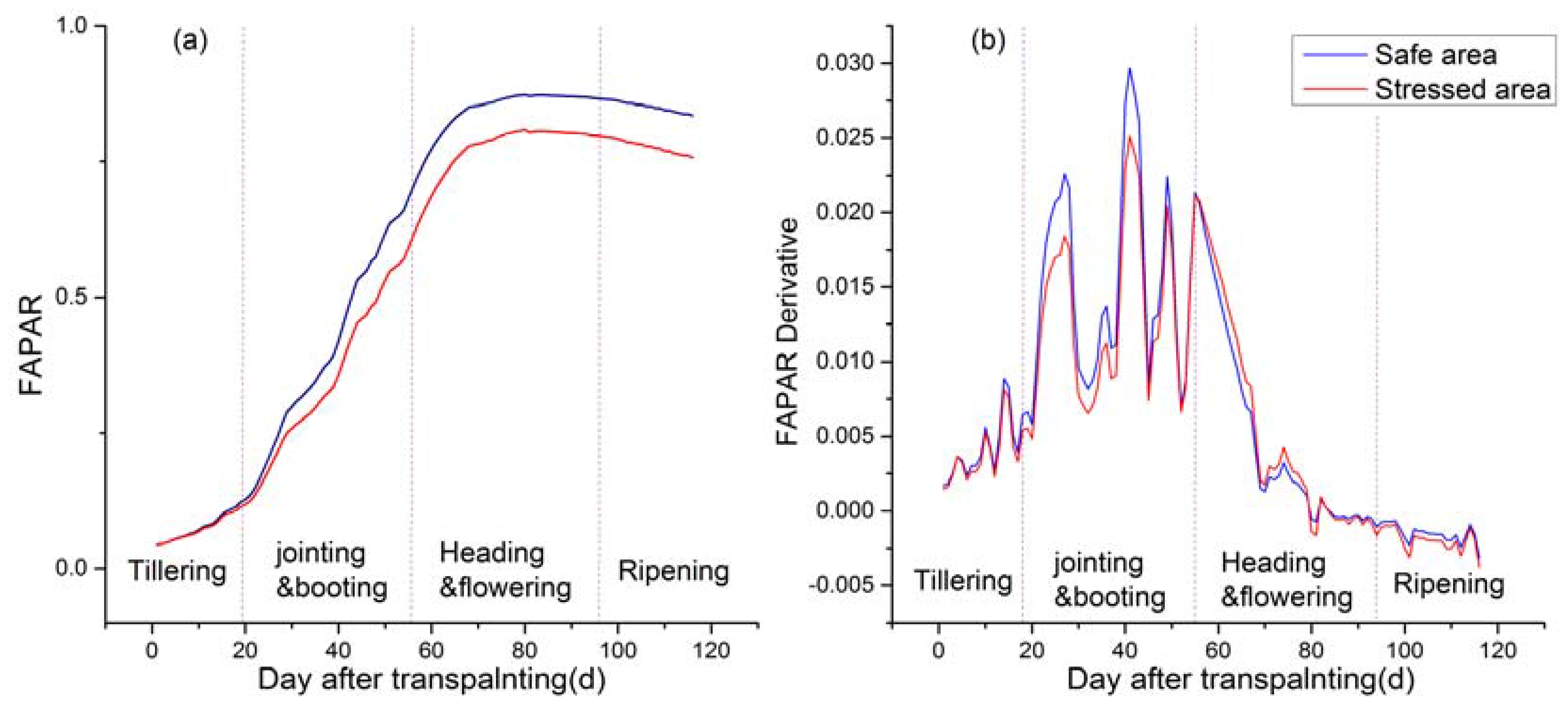
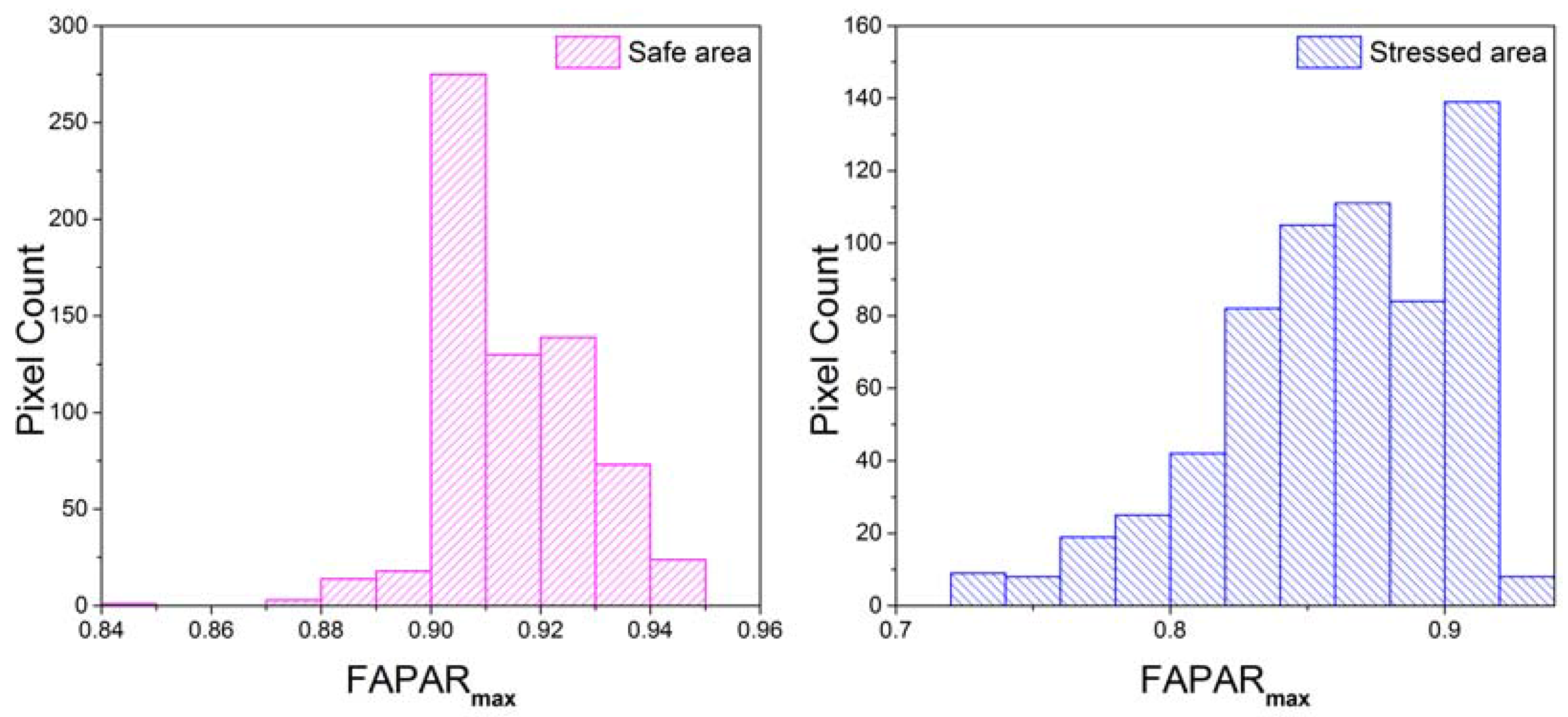
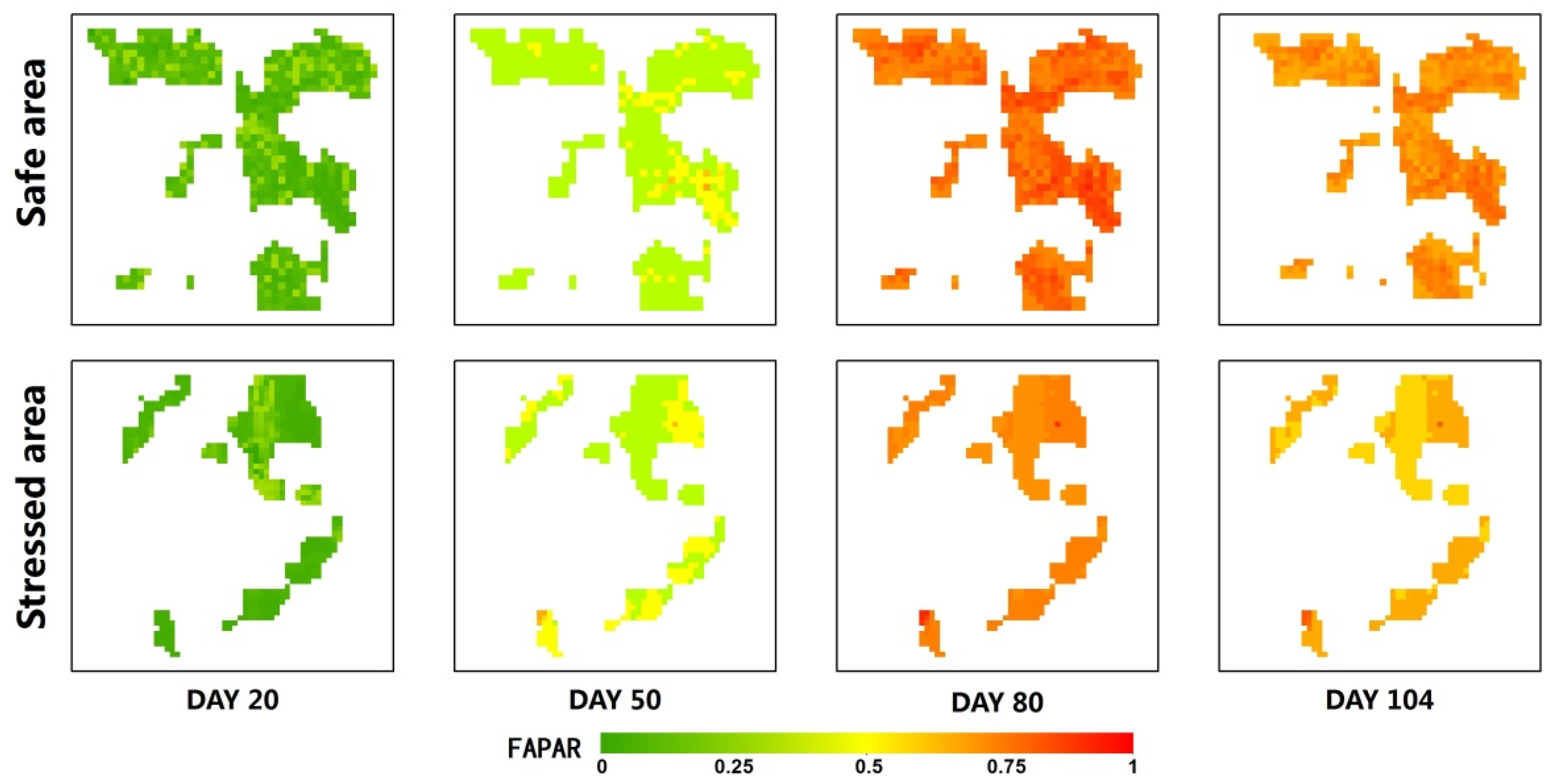
| Study Area | Coordinates | Type | Cd | Hg | Pb | As | Pollution Level |
|---|---|---|---|---|---|---|---|
| Background Value (mg/kg) | 1.43 | 0.20 | 82.78 | 19.11 | |||
| A | 27°47.5′N 113°12.5′E | Soil (mg/kg) | 0.84 | 0.82 | 78.32 | 10.22 | Safe Level |
| Rice Tissues (mg/kg) | 0.82 | 0.04 | 10.60 | 5.39 | |||
| B | 27°50.4′N 113°2.6′E | Soil (mg/kg) | 3.28 | 0.51 | 120.75 | 18.15 | Stress level |
| Rice Tissues (mg/kg) | 2.97 | 0.06 | 36.73 | 7.04 |
| Parameter (Unit) | Description | Value | Source | |
|---|---|---|---|---|
| Phenological Parameters | IDEM (day) | Day of transplanting | 154 | Field measurements |
| TSUM1 (°C) | Cumulative temperature from emergence to anthesis | 1800 | Field measurements | |
| TSUM2 (°C) | Cumulative temperature from anthesis to maturity | 620 | Field measurements | |
| DVSI | Development stage of transplanting | 0.25 | Field calibration | |
| Crop initial Condition Parameters | TDWI (kg∙ha−1) | Initial total crop dry weight | 65 | Field measurements |
| LAIEM (ha∙ha−1) | Leaf area index at emergence | 0.1 | Field measurements | |
| Green Area Parameter | SPAN (day) | Life span of leaves growing at 35 °C | 50 | From previous studies |
| TBASE (°C) | Lower threshold temperature for aging of leaves | 15 | From previous studies |
| Parameter | Default Value | Unit | Note and Reference | |
|---|---|---|---|---|
| Illumination Parameter | SKYL | Calculated by WOFOST model | − | fraction of diffused incoming solar radiation |
| SZA | Consistent with remote sensing data | ° | Sun zenith angle | |
| VZA | Consistent with remote sensing data | ° | View zenith angle | |
| RAA | Consistent with remote sensing data | ° | Relative azimuth angle | |
| Leaf Parameter | Ns | 1.5 | − | Leaf mesophyll structure parameter |
| Cab | 40.194 | μg∙cm−2 | Leaf chlorophyll content | |
| Cw | 0.0 | g∙cm−2 | Leaf water content | |
| Cm | 0.0064 | g∙cm−2 | Leaf dry matter content | |
| Car | 0.0036 | μg∙cm−2 | Leaf carotenoid content | |
| Canopy Parameter | ALA | 70 | ° | Averaged leaf angle |
| LAI | Calculated by WOFOST model | − | Leaf area index | |
| Hotspot | 0.05 | − | Hotspot size parameter | |
| Psoil | 0 | − | Soil bright index |
© 2017 by the authors. Licensee MDPI, Basel, Switzerland. This article is an open access article distributed under the terms and conditions of the Creative Commons Attribution (CC BY) license (http://creativecommons.org/licenses/by/4.0/).
Share and Cite
Zhou, G.; Liu, X.; Zhao, S.; Liu, M.; Wu, L. Estimating FAPAR of Rice Growth Period Using Radiation Transfer Model Coupled with the WOFOST Model for Analyzing Heavy Metal Stress. Remote Sens. 2017, 9, 424. https://doi.org/10.3390/rs9050424
Zhou G, Liu X, Zhao S, Liu M, Wu L. Estimating FAPAR of Rice Growth Period Using Radiation Transfer Model Coupled with the WOFOST Model for Analyzing Heavy Metal Stress. Remote Sensing. 2017; 9(5):424. https://doi.org/10.3390/rs9050424
Chicago/Turabian StyleZhou, Gaoxiang, Xiangnan Liu, Shuang Zhao, Ming Liu, and Ling Wu. 2017. "Estimating FAPAR of Rice Growth Period Using Radiation Transfer Model Coupled with the WOFOST Model for Analyzing Heavy Metal Stress" Remote Sensing 9, no. 5: 424. https://doi.org/10.3390/rs9050424





